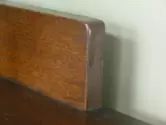Finding and Defining an Original Finish

Is an “over-coated” finish still an original finish?
Is a “cleaned” finish still an original finish?
These are all critical questions to any furniture collector, for it has been proven time and time again that a piece with its original finish (1.) commands a higher price and (2.) increases in value faster and more significantly.
Identifying an original finish is not difficult, provided you know what to look for and where to look. For starters, look for wear in all the right places: around pulls, on edges and corners, on stretchers, and around the feet. Nothing survives a century of use without some wear. An even, flawless color and finish may well be a new — or at least a restored — finish.
Next, inspect the hardware, looking for sanding scratches, over-coats of finish, or signs that a screwdriver has recently been in the slot of the screw. All could be indications that the piece has been worked over.
Third, pull out every drawer and turn it over. Check the sides and the bottom for drips or runs of a fresh finish (pictured) or scars left by a chemical remover. Look at the back, especially at the edge where the sides join the back. Ask the owner to lay the piece on its back and do the same for the bottom. Expect to find cobwebs, spider eggs, and a little mold or mildew.
Finally, use your nose. With just a little practice you can learn the distinct almost moldy, stagnant odor of old, undisturbed shellac. If it’s missing or if you smell fresh lacquer, shellac, oil or varnish, get suspicious.
But what about those enhanced, cleaned, and over-coated finishes?
“Enhanced” typically means the same as “over-coated” — a second application of finish has been applied over the original finish. Over-coats are sometimes sloppy, whereas an enhanced finish may be a coat of hand-mixed shellac carefully applied by a professional restorer. While an enhanced finish may look better than an over-coat, neither qualifies as an original finish. And neither can be removed without damaging the original finish.
“Cleaning” is generally an understatement. A typical household cleaning, even with a soapy dishcloth, does not remove half of the original finish over the entire piece. Scrubbing the piece with strong ammonia, denatured alcohol, or lacquer thinner does. For decades this had been a common practice among those who did not like the look of a dark, original Arts & Crafts finish. While the little finish that remains is original, the problem is that anything done to restore it will forever label the antique as being “enhanced” or “over-coated.”
So, should you buy a piece has does not have its original finish?
Absolutely. Several of the pieces in my collection have been refinished.
Just know what finish you are buying, and make sure you are not paying the same as you would for the identical form with an original finish.
Good Luck!
– Bruce
Top photo – An original finish on a Gustav Stickley bookcase, evidence by the chip, the uneven color, and the accumulation of dust in the corner around the keyed tenon.
Bottom photo – A drip of an over-coat of finish on the splashboard of a server.

